Pump Handbook by Igor J. Karassik, Joseph P. Messina, Paul Cooper, Charles C. Heald - 3rd edition
Подождите немного. Документ загружается.

3.5 DISPLACEMENT PUMP FLOW CONTROL 3.83
contracyclically with the reciprocating pump pulsations. The magnitude of the centrifu-
gal pump flow variation due to the positive displacement pump pulsations is a function
of the system head curve, the centrifugal pump head-capacity curve, the degree of flow
pulse imposed on the centrifugal pump discharge header, and the liquid bulk modulus (or
compressibility).
FLOW CONTROL IN POSITIVE DISPLACEMENT PUMPS IN SERIES___________
Whenever positive displacement pumps are installed in series (such as for multiple-
station pipeline service), some variable-capacity capability is mandatory. Otherwise, any
variation in capacity between series pumps or series groups of pumps would result in dis-
astrous interstation pressures.
The flow is determined by the first pump in the line. Subsequent pumps should be
equipped with capacity controls responsive to their inlet pressures. The preferred control
is a continuous-modulation type, such as variable speed, unless large reservoir capacity is
available between pumps.
Recirculation from discharge to suction through a throttling bypass valve may be used,
at the expense of energy, to match the delivery from downstream pumps to upstream
pumps. Excessive bypass flow in relation to through flow can result in significant tem-
perature rise of the liquid.
When downstream pump capacity is less than the upstream delivery, the interpump
pressure will rise, indicating a need for increased capacity. When the downstream pump
capacity exceeds the upstream delivery, the downstream pump will “draw down” the inter-
pump pressure to the point where net positive inlet pressure difficulties are ensured.
Reservoir accumulators between pumps permit a limited degree of mismatch in capac-
ities, allowing the use of incremental capacity controls, such as suction valve unloading
and intermittent pump bypass.
In any event, effective discharge dampeners on the upstream pump and suction stabi-
lizers on the downstream pump are necessary to prevent the inherent pressure pulsations
and control modulation variances from adversely affecting operation.
FLOW CONTROL IN POSITIVE DISPLACEMENT PUMPS IN PARALLEL________
Because the capacity of positive displacement pumps is virtually independent of head,
there is no problem from the head-capacity characteristics in parallel operation
—
even for
pumps of different sizes.
Particular attention to suction acceleration head requirements is necessary when more
than one pump is taking suction from a common suction pipe. Because it cannot be
assured that two pumps will not, at some point, have simultaneous suction strokes, the
acceleration head requirements of each pump must be added for that portion of the suc-
tion line that furnishes the total flow. This suggests extra large suction lines, individual
ones from the liquid source, or suction stabilizers sized for the total flow with individual
outlet connections for each pump.

STEPHEN D. ABLE
ROBERT BEAN
WARREN E. RUPP
3.85
SECTION 3.6
DIAPHRAGM PUMPS
Diaphragm pumps are a class of displacement pumps featuring flexible membranes in
combination with check valves that are used to move fluids into and out of pumping cham-
ber(s). These pumps are used extensively in transfer and metering applications requiring
flows of up to 300 gallons per minute (1150 liters per minute). They are quite versatile,
handling a wide variety of fluids including chemicals, dry powders, food additives, glues,
paints, pharmaceutical products, slurries, tailings, and wastewater. A distinguishing fea-
ture of all diaphragm pumps is the absence of seals or packing, meaning they can be used
in applications requiring zero leakage. There are three main categories of diaphragm
pumps: 1) mechanically driven, 2) hydraulically driven, and 3) air-operated.
MECHANICALLY DRIVEN DIAPHRAGM PUMPS ___________________________
Many industries are served by mechanically driven diaphragms pumps. They are used in
construction, chemical, and water treatment applications.
Construction Industry Mechanically driven diaphragm pumps are widely used in the
construction industry for dewatering applications where pumps may ingest rocks or other
debris.A popular make of this type of pump contains a spring on the plunger rod (see Fig-
ures 1 and 2). If the operating pressure exceeds the maximum recommended pumping
pressure, the spring compresses and does not move the diaphragm. The spring can com-
press and thus keep a rock from being pushed through the wall of the pumping chamber
or cause the drive mechanism to fail.
In single-diaphragm pumps, the pumped liquid can have a lot of inertia if the suction
and discharge lines are relatively long. A simple accumulator on the suction (inlet) side of
the pump enables the pump to draw liquid from the accumulator while it simultaneously
draws liquid through the suction line.
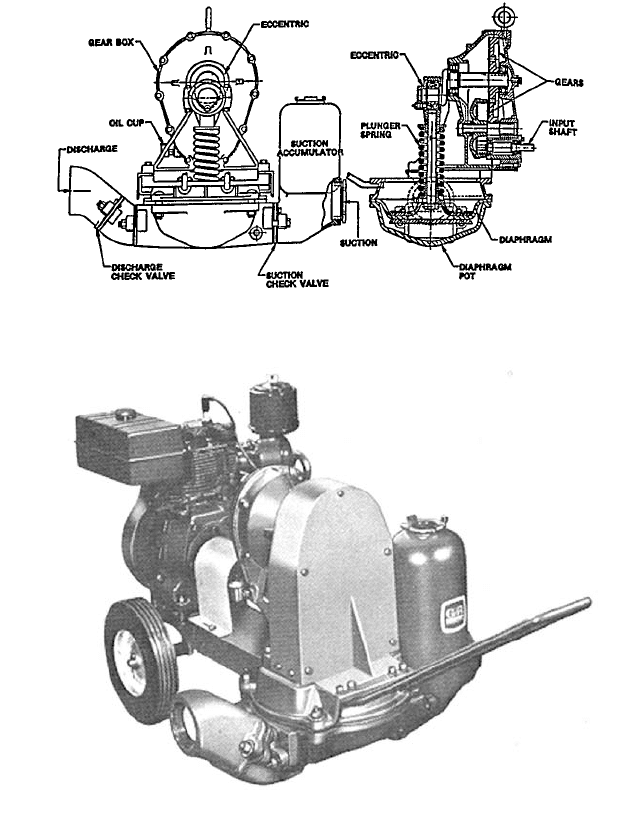
3.86 CHAPTER THREE
FIGURE 1 Cross-section of a mechanically driven single-diaphragm pump for the construction industry
(Gorman-Rupp)
FIGURE 2 Mechanically driven single-diaphragm pump, engine-powered (Gorman-Rupp)
During the discharge stroke, the accumulator can refill with liquid from the suction
line. If the discharge line from the pump is relatively long, the inertia of the liquid can be
great, as mentioned earlier, and can impose severe loads on the diaphragm and drive
mechanism.The spring on the plunger rod can absorb some of the drive energy early in the
discharge stroke and “give it back” during the latter part of the discharge stroke, greatly
reducing the inertia loading on the diaphragm and drive mechanism.
Mechanically driven diaphragm pumps in the construction industry operate by a recip-
rocating plunger, usually secured to plates on both sides of the diaphragm.The diaphragms
are customarily fabric-reinforced elastomers (usually synthetic rubbers) similar in many
ways to the fabric-reinforced materials used in pneumatic tires. The diaphragms are nor-
mally molded with a convoluted section between the central clamped area and the clamped
periphery. This convoluted section permits longer strokes than would be possible otherwise.
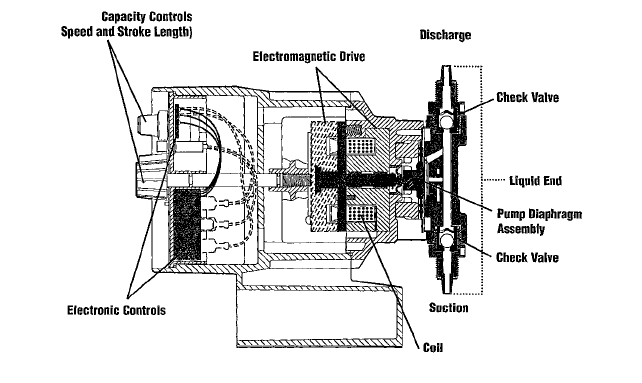
3.6 DIAPHRAGM PUMPS 3.87
FIGURE 3 Electromagnetic diaphragm pump (Milton-Roy, subsidiary of Sundstrand Corp.)
These pumps are sometimes duplexed so that the reciprocating means acts alternately
on two diaphragms with one on a suction stroke, while the other is on a discharge stroke
and vice versa. A connector called a walking beam is pivoted between two diaphragms.As
one diaphragm is pushed down on a discharge stroke, the other diaphragm is simultane-
ously pulled up on a suction stroke. The pumping chambers with inlet and outlet check
valves are manifolded together to a common inlet and a common outlet. The principle
advantage of the duplex diaphragm pump is its more constant flow (two pressure pulsa-
tions per cycle).
Mechanically driven diaphragm pumps are used in the construction industry for dewa-
tering foundations and cofferdams, as well as in sewage treatment plants for pumping
lime slurries.They are normally limited to 50 ft (15.2 m) of differential head and are capa-
ble of suction lifts of as much as 25 ft (7.6 m).
Chemical and Water Treatment Industries Another type of mechanically driven dia-
phragm pump is used for the injection or transfer of chemicals into process streams at pres-
sures up to 250 lb/in
2
(17 bar). These pumps are designed to enable the easy adjustment of
their capacities, so precise volumes of chemicals can be injected. Typically, capacities can be
adjusted through a 20:1 range. Injection repeatability is generally plus or minus 3%.
A wide range of chemicals can be handled. Wetted materials include PVC, PVDF,
Polypropylene, 316SS, Alloy 20, and Alloy C22. Diaphragms are PTFE or PTFE with elas-
tomeric backing. Ball type check valves are usually employed.
Applications for this type of pump include the injection of acids and bases for pH con-
trol, biocides, chlorination, coagulants, and fertilizers. There are two basic configurations
for pumps in this class: electromagnetic pumps (solenoid) and motor-driven pumps.
Electromagnetic (electronic) pumps (see Figure 3) are used in a variety of low-power
applications with flows from 0.026 to 26 gallons per hour (0.1 to 100 liters per hour) at pres-
sures up to 250 lb/in
2
(17 bar). These metering pumps employ an electronic control circuit
that pulses an electromagnet that, in turn, generates the linear motion of an armature-
shaft-diaphragm assembly. Each electronic pulse results in one discharge stroke of the
pump. At the end of the stroke, a set of springs returns the diaphragm assembly to its ini-
tial position, drawing more fluid into the pump chamber in preparation for the next stroke.
These pumps are inherently safe, as they can be run indefinitely in the stalled condi-
tion without damage to the pump or overpressuring most systems. An additional feature
of certain electronic pumps is the regulation of pulse strength through electronic power
control, which leads to smoother fluid injection. Capacity is usually controlled by adjust-

3.88 CHAPTER THREE
FIGURE 4 Diaphragm of a typical mechanical lost motion mechanism (Milton-Roy, subsidiary of Sundstrand
Corp.)
ing the stroke rate, but the stroke length can also be adjusted. Combining these adjust-
ments provides a wide range of outputs.
Advances in the electronic controls have led to the capability to control output manu-
ally from 4–20 mA process signals, digital pulses from external sources (such as flow
meters), or serial data communications signals from computers.Yearly maintenance is rec-
ommended for low-pressure applications, but as pressures rise, diaphragms and check
valves will need to be replaced more frequently.
Motor-driven, mechanically actuated diaphragm pumps are used in applications for flows
from 2 to 300 gallons per hour (approximately 10 to 1000 liters per hour) again at pressures
up to 250 lb/in
2
(17 bars). Since motor-driven, mechanically actuated diaphragm pumps are
positive displacement pumps, capacities cannot be adjusted by the use of a throttling valve.
Three techniques are used in the industry to adjust motor-driven pump capacities.
Some designs employ the use of a “mechanical lost motion” mechanism in which an
adjustable mechanical stop interrupts the spring-loaded crosshead from following the cam
for a portion of the stroke. This decreases the effective stroke length (see Figure 4). Other
designs employ the use of an adjustable crank machined with a “variable eccentricity.”The
adjustment of the crank’s position changes the pump’s effective stroke length (see Figure
5). The third design technique is the use of AC or DC variable speed motors.
At higher flow rates, attention should be paid to the system design to ensure the proper
handling of pressure pulsations, due to the acceleration and deceleration of the process fluid
in the lines.This is especially true for pumps having a mechanical lost motion configuration,
due to the diaphragm’s rapid starts and stops. In the higher flow systems, pulsation damp-
eners are frequently employed in the discharge lines and occasionally need to be used in the
suction lines to control pulsations. When discharge pressures are low, backpressure valves
are employed to provide a system pressure sufficient to decelerate the fluid in the suction
line at the end of every suction stroke. If the flow of the process fluid in the suction line has
not stopped by the beginning of the discharge stroke, the accuracy of the injection is dimin-
ished. Yearly maintenance is recommended for low-pressure applications, but as pressures
rise, diaphragms and check valves will need to be replaced more frequently.
Other Mechanically Driven Diaphragm Pumps Automotive fuel pumps are usually
of the diaphragm type.The diaphragm is moved mechanically by a cam on a suction stroke
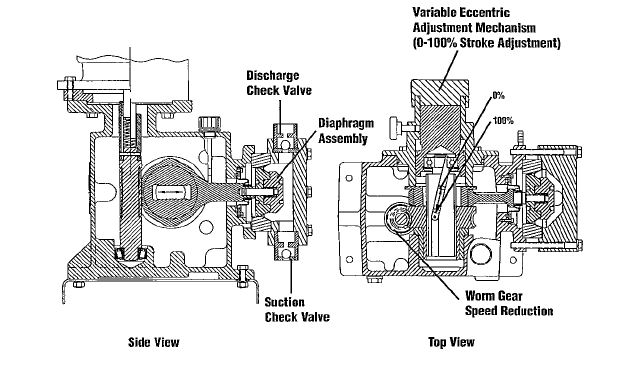
3.6 DIAPHRAGM PUMPS 3.89
FIGURE 5 Cross-section of a variable eccentric mechanically driven diaphragm pump (Milton-Roy, subsidiary of
Sundstrand Corp.)
and is returned by a spring for the discharge stroke. Thus, the spring determines the dis-
charge pressure and provides a nearly constant pump pressure to the carburetor regard-
less of the pump (engine) speed or the rate of fuel consumption. Hand-operated diaphragm
pumps are used extensively as bilge pumps on sailboats where the loss of power is a major
concern and hand operation is essential.
HYDRAULICALLY DRIVEN DIAPHRAGM PUMPS___________________________
Hydraulically driven diaphragm pumps are used in applications for the transfer or injec-
tion of chemicals into process streams at pressures up to 7500 lb/in
2
(approximately 500
bar). Because the diaphragm is pressure-balanced, the stresses in the diaphragms are low.
Therefore, these pumps tend to require minimal maintenance. The pump’s capacities can
be adjusted to match the specific process requirement by adjusting the effective stroke
length or stroking speed of the pump. Effective stroke lengths are adjusted by either a
hydraulic lost motion, a mechanical lost motion, or by varying the eccentric’s offset. The
repeatability of the injected flow is plus or minus 1% or better.
Applications range from 0.26 to 26,000 gallons per hour (1 to 100,000 liters per hour).
At flows above 26 gallons per hour (100 liters per hour), most pump models employ capac-
ity adjustments based on variable eccentric or variable speed technology to avoid signifi-
cant pressure spikes due to the rapid acceleration and deceleration of the fluid in the pipes.
As with the mechanical diaphragm pumps, a wide range of chemicals can be handled.
Wetted materials include PVC, Polypropylene, PVDF, 316 SS, Alloy 20, Alloy C-22, Tita-
nium, and Inconel. Diaphragms for pressures up to 4350 lb/in
2
(300 bar) are typically com-
posed of PTFE or PTFE with an elastomeric backing. Diaphragms above 4350 lb/in
2
(300
bar) are typically 316 SS, Alloy C, or PEEK. Optional features include fluid temperature
control jackets, diaphragm rupture detection capabilities, and remote diaphragm head
designs. Typical applications include the injection of acids and bases for pH control, cor-
rosion inhibitors, methanol, coagulants, primary process blending, process slurries, and
drag reducers.Three types of liquid ends are used: the disc diaphragm, shown in Figure 6,
the tubular diaphragm in Figure 7, and the high performance diaphragm in Figure 8.
The disc diaphragm pump is equipped with process-side and suction-side restraining
plates to prevent overdisplacement of the diaphragm during system upsets. When the
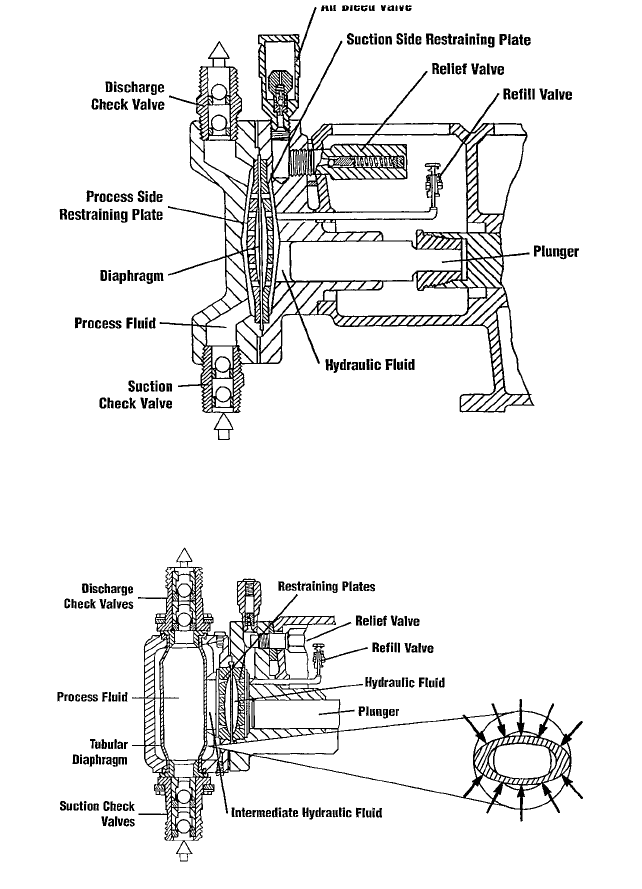
3.90 CHAPTER THREE
FIGURE 6 Diagram of a disc diaphragm pump (Milton-Roy, subsidiary of Sundstrand Corp.)
FIGURE 7 Diagram of a tubular diaphragm configuration (Milton-Roy, subsidiary of Sundstrand Corp.)
diaphragm reaches the suction-side restraining plate, the hydraulic oil pressure drops,
causing the refill valve to open and replenish the oil. When the diaphragm hits the
process-side restraining plate, the hydraulic pressure rises, causing the relief valve to
open, venting some oil. The fluid volume between the restraining plates is typically 150%
of the maximum displaced volume of the pump.Therefore, the diaphragm does not contact
both restraining plates during the same stroke.
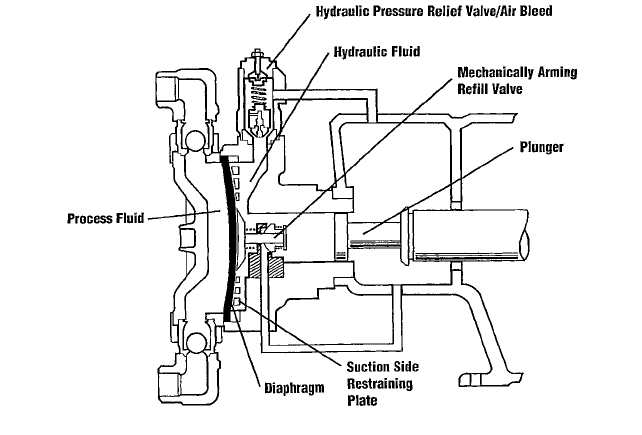
3.6 DIAPHRAGM PUMPS 3.91
FIGURE 8 Diagram of a high performance diaphragm design (Milton-Roy, subsidiary of Sundstrand Corp.)
The tubular diaphragm configuration is a variation of the disc diaphragm design. A
diaphragm shaped in the form of a tube is placed in a chamber in front of the disc
diaphragm assembly. This design eliminates the process fluid flowing through the front-
restraining plate, reducing viscous losses and wear in case of slurries. The chamber must
be filled with a precise amount of hydraulic fluid to avoid overdisplacing the tube.
The high-performance diaphragm configuration eliminates the use of a process-side
restraining plate providing the throughflow performance of a tubular design while elimi-
nating the possibility of overdisplacing the tube during startup and maintenance. With a
mechanically arming, pressure-sensitive refill valve, the hydraulic fluid can only be
replenished when the diaphragm is in the most rearward position. This eliminates the
possibility of overfilling the hydraulic chamber and therefore overdisplacing the
diaphragm during system upsets (blocked suction or discharge lines).
Most problems with hydraulic diaphragm pumps occur due to incorrect system
designs. Pressures above 9 lb/in
2
(0.6 bar) should be maintained in the pump diaphragm
heads during the suction stroke to stop vapor buildups in the hydraulic or process-side
cavities. Pressures at 3 lb/in
2
(0.2 bar) can be handled in some applications with modified
designs and special hydraulic fluids. NPSH calculations should include viscous losses in
the check valves and contour plates (if so equipped).
In addition, since hydraulic diaphragm pumps are reciprocating machines, accelera-
tion losses also have to be considered. Peak acceleration/deceleration losses occur at the
beginning and end of the stroke, while peak viscous losses occur at midstroke. The losses
are not additive.The manufacturer should be contacted to provide guidance in performing
these calculations.
As with mechanically driven diaphragm pumps, at higher flows, pulsation dampeners
should be considered to ensure the proper handling of pressure pulsations due to the accel-
eration and deceleration of the process fluid in the lines. This is especially true for pumps
having a mechanical lost motion configuration due to the diaphragm’s rapid starts and
stops. When discharge pressures are low, backpressure valves are employed to provide a
system pressure sufficient to decelerate the fluid in the suction line at the end of every suc-
tion stroke. If the flow of the process fluid in the suction line has not stopped by the begin-
ning of the discharge stroke, the accuracy of the injection is compromised.
3.92 CHAPTER THREE
AIR-OPERATED DIAPHRAGM PUMPS (AODPS) ___________________________
In general, diaphragm pumps of all types are sealless, have no dynamic seals or packing,
are self-priming, and have an infinitely variable flow rate and pressure rate within the
pressure and capacity ranges of the pump. Air-operated diaphragm pumps (AODPs) can
also run dry indefinitely, and the discharge can be throttled to zero flow indefinitely.
The most common types of AODPs are the double-diaphragm pumps (duplex pumps).
These contain two diaphragm chambers and two flexible diaphragms. The diaphragms are
connected to each other through a connecting rod and are clamped at the outer edges of
the diaphragm. The shaft-connected diaphragms move in the same linear direction simul-
taneously. Compressed air directed to the back side of the left diaphragm moves both
diaphragms to the left, while air is exhausted to the atmosphere from the back side of the
right diaphragm. After completion of a stroke, an air distribution valve directs compressed
air from the supply to the back side of the right diaphragm and exhausts air to the atmos-
phere from the left chamber. This continuous reciprocating motion, along with properly
operating internal check valves, creates an alternating intake and discharge of pumped
liquid into and out of each chamber that results in a nearly continuous pumping action
from the combined chambers.
A diaphragm pump air motor contains an air distribution valve that shifts positions at
the end of each stroke of the pump.The air distribution valve alternately directs supply air
pressure to one chamber and exhausts the other. Air motors often use a two-stage valve to
control the reciprocating motion of the pump (see Figure 11). The pilot valve supplies a
pilot air pressure signal to the air distribution valve throughout the entire stroke of the
pump, even though pressure oscillations in the pumping system may occur. The pilot valve
is not connected directly to the diaphragm’s connecting rod, which provides a “deadband”
to prevent the power valve from erroneously shifting just after the end of each stoke. The
two views contained in Figure 11 depict the position of the moving parts just before the
pilot valve is moved by its contact with the diaphragm washer. Depending on its position,
the pilot rod alternately pressurizes and exhausts the large end of the air distribution
valve. Other valve design configurations pressurize and exhaust both ends of the air dis-
tribution valve.
The two common types of liquid check valves that are used in a diaphragm pump are
the flap valve and the ball valve. A flap valve pump (see Figures 9 and 10) can handle
nearly marble-sized solids. Because the discharge is from the bottom of the diaphragm
chambers, the pump is ideally suited for pumping solids in suspension that may tend to
settle out, particularly when the pumping rate is reduced or when the pump is shut down.
The bottom outlet enables foreign matter to be easily pumped out of the chambers.
The popular air-operated, double-diaphragm pump with ball valves (see Figures 12
and 13) features the inlet at the bottom of the diaphragm chambers, and the outlet is at
the top. The top discharge arrangement has the advantage of enabling air or vapors to be
easily expelled from the chambers. Trapped air or vapors in pumps having bottom outlets
can reduce the volumetric displacement of the pumps as the air or vapor is alternately
compressed and expanded, instead of the liquid being displaced. This can be a concern in
low-flow applications requiring relatively high pumping pressure and that handle viscous
liquids. In higher flow applications, a sufficient turbulence is present and air or vapors mix
with the pumped liquid to purge the pumping chambers of the gases.
The performance chart of a typical 2-in (51-mm) air-operated, double-diaphragm pump
(see Figure 14) is similar to that of other pump types but contains air consumption rather
than horsepower consumption. With a constant supply pressure of compressed air, work
and energy relationships in the air chambers, as well as liquid flow losses within the
pump, result in a downward sloping head-capacity curve, similar to a centrifugal pump.
The following are noteworthy features of air-operated diaphragm pumps:
• With the pump shut off, there is no power consumption. Air consumption is
approximately proportional to the flow rate; there is zero air consumption at a zero flow
rate and maximum air consumption at a maximum flow rate. This feature enables
diaphragm pumps to be used in applications where the flow rate must be varied over
a wide range or from no flow to a high flow rate.

3.6 DIAPHRAGM PUMPS 3.93
FIGURE 9 Cross-section of an air-operated double-diaphragm pump with flap check valves (Ingersoll-Rand Fluid
Products)
• The pump discharge pressure remains the same for a given capacity and air inlet pres-
sure regardless of the specific gravity of the liquid being pumped. The discharge head
varies with the specific gravity of the pumped fluid, because pressure and not head is
primarily maintained by the air pressure. For centrifugal pumps, the discharge pressure
is directly proportional to the specific gravity of the liquid being pumped, while head is
fixed at a given point on the performance curve. The supplied air pressure, pump flow
rate, and NPSH set the discharge pressure for a given air operated pump, not the head,
which is a characteristic of a centrifugal pump operated at a fixed speed.
• The NPSH required for an air-operated diaphragm pump is defined in the same man-
ner as with any reciprocating pump. The NPSH required is determined to occur when
the volumetric efficiency drops by a measurable amount (normally 3%) at a fixed speed
or flow rate.
MATERIALS OF AIR-OPERATED DIAPHRAGM PUMPS _____________________
Check valves for diaphragm pumps are of three types: flap, ball, and poppet (see Figure
15). Flap valves preferably hang in a vertical position with a horizontal flow through the
valves. Their principle advantage is the capability to handle large objects in suspension.
Flap valves with elastomeric hinges are extensively used. Ball valves are arranged to pro-
vide a vertical flow through the valve seats. Poppet valves are usually guided by a valve
stem and are spring-loaded. The poppet type of valve is not position-sensitive and can
